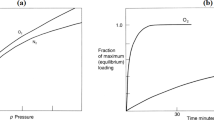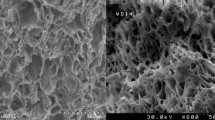Abstract
Permeation of N2, CH4, O2 and CO2 molecules through a carbon molecular sieve (CMS) was studied over a wide range of pressures using the transport mechanism. For proper utilization of carbon molecular sieve membrane in gas separation processes, prediction of behavior and recognition of proper gas transport mechanism as well as finding effective permeation parameters are necessary. A mathematical model of the gas transfer through a CMS membrane was developed using genetic algorithm (GA). Numerous types of mechanisms have been proposed so far for gas transport through capillaries, namely: Knudsen, slip and viscous flow. Moreover, surface flow usually occurs in parallel with other transport mechanisms such as Knudsen or viscous flow. The experimental data of gas permeation in CMS membranes and an appropriate genetic algorithm-based optimization method were used to establish the transport parameters. A GA, an optimization procedure based on the theory of evolution, was compared with non-linear regression for the ability of these two algorithms to fit the coefficients of Poultry growth models. It was found that GA approach could be more capable to define the parameters of permeation equation than non-linear regression. The model in most cases showed a good agreement between the predicted and measured values of the permeability.







Similar content being viewed by others
Abbreviations
- r :
-
Pore radius
- λ :
-
Mean free path
- T :
-
Temperature in K
- R :
-
Constant of gas
- N :
-
Number of Avogadro
- d :
-
Gas molecules collision diameter in m
- \(\overline{p}\) :
-
Membrane average pressure as \(\overline{p}\) = (p f − p p )/2
- p f :
-
Feed pressures in Pa
- p p :
-
Permeate pressures in Pa
- N su :
-
Surface flow of membrane
- A p :
-
Pores cross sectional area in m2
- ρ app :
-
Membrane density in kg/m3
- τ :
-
Factor of tortuosity
- L :
-
Pore length in m
- CR:
-
Resistance coefficient in kg/m2.s
- S s :
-
Specific surface area of the solid on which the adsorbed molecules are mobile in m2
- x :
-
Adsorbed amount per unit weight of the membrane in kmol/kg
- N(r):
-
Function of normal pore size distribution in m−1
- \(\bar{r}\) :
-
Mean pore radius in m
- n :
-
Total pores number on a membrane surface
- σ :
-
The standard deviation of pore size distribution in m
- q :
-
Concentration of the adsorbed phase
- q s :
-
Saturation capacity
- b :
-
Affinity coefficient
- J total :
-
Total gas flow
- N g :
-
Flow in the gas phase
- N Su :
-
Surface flow
References
Freeman BD, Yampolskii Y, Pinnau I (2006) Materials science of membranes for gas and vapor separation. John Wiley & Sons, Chichester
Li K (2007) Ceramic membranes for separation and reaction. John Wiley & Sons, Chichester
Farrokhnia M, Rashidzadeh M, Safekordi A, Khanbabaei G (2015) Fabrication and evaluation of nanocomposite membranes of polyethersulfone/α-alumina for hydrogen separation. Iran Polym J 24:171–183
Ismail AF, Rana D, Matsuura T, Foley HC (2011) Carbon-based membranes for separation processes. Springer, London
Ashraf R, Kausar A, Siddig M (2014) High-performance polymer/nanodiamond composites: synthesis and properties. Iran Polym J 23:531–545
Panday P, Chauhan RS (2001) Membrane for gas separation. Prog Polym Sci 26:853–893
Pirouzfar V, Hosseini SS, Omidkhah MR, Moghaddam AZ (2014) Investigating the effect of dianhydride type and pyrolysis condition on the gas separation performance of membranes derived from blended polyimides through statistical analysis. J Ind Eng Chem 20:1061–1070
Pirouzfar V, Hosseini SS, Omidkhah MR, Moghaddam AZ (2014) Modeling and optimization of gas transport characteristics of carbon molecular sieve membranes through statistical analysis. Polym Eng Sci 54:147–157
Hosseini SS, Omidkhah MR, Moghaddam AZ, Pirouzfar V, Krantz WB, Tan NR (2014) Enhancing the properties and gas separation performance of PBI-polyimides blended carbon molecular sieve membranes via optimization of pyrolysis process. Sep Purif Technol 122:278–289
Pichaiyut S, Nakason C, Vennemann N (2012) Thermoplastic elastomers-based natural rubber and thermoplastic polyurethane blends. Iran Polym J 21:65–79
Rao MB, Sircar S (1993) Nanoporous carbon membranes for separation of gas mixtures by selective surface flow. J Membr Sci 85:253–264
Aalaie J, Vasheghani-Farahani E (2012) Swelling behavior of sulfonated polyacrylamide nanocomposite hydrogels in electrolyte solutions: comparison of theoretical and experimental results. Iran Polym J 21:175–183
Liu H, Xiao C, Huang Q, Fan Z, Hu X, Shu W (2015) Study on interface structure and performance of homogeneous-reinforced polyvinyl chloride hollow fiber membranes. Iran Polym J 24:491–503
Hsieh HP (1988) Inorganic membranes. AIChE Symp Ser 84:1–18
Shiflett MB, Foley HC (1999) Ultrasonic deposition of high-selectivity nanoporous carbon membranes. Science 285:1902–1905
Goldberg DE (1989) Genetic algorithms in search, optimization, and machine learning. Addison-Wesley Longman Publishing, Boston
Michalewicz Z (1993) A hierarchy of evolution programs: an experimental study. Evol Comput 1:51–76
Haupt RL, Haupt SE (1992) Practical genetic algorithms. John Wiley & Sons, New Jersey
Liepmann HW (1961) Gas kinetics and gas dynamics of orifice flow. J Fluid Mech 10:65–79
Kong J, Li K (2001) An improved gas permeation method for characterizing and predicting the performance of microporous asymmetric hollow fiber membranes used in gas absorption. J Membr Sci 182:271–281
Karger J, Ruthven DM (1992) Handbook of zeolite science and technology. CRC Press
Gilliland E, Baddour RF, Russel JL (1958) Rates of flow through microporous solids. AIChE J 4:90–96
Chent YD, Yang RT (1994) Preparation of carbon molecular sieve membrane and diffusion of binary mixtures in the membrane. Ind Eng Chem Res 33:3146–3153
Kiyono M, Williams PJ, Koros WJ (2010) Effect of polymer precursors on carbon molecular sieve structure and separation performance properties. Carbon 48:4432–4441
Momeni M (1997) Transport of multi-component gas mixture through membranes. M.S. Thesis, Department of Chemical Engineering, Sharif University of Technology, Tehran, Iran
Mustafa A (2006) Development of asymmetric carbon hollow fiber membrane for gas separation. Membrane Research Unit Faculty of Chemical and Natural Resources Engineering, University Technology Malaysia
Jones CW, Koros WJ (1994) Carbon molecular sieve gad separation membranes-I preparation and characterization based on polyimide precursors. Carbon 32:1419–1425
Author information
Authors and Affiliations
Corresponding author
Rights and permissions
About this article
Cite this article
Pirouzfar, V., Omidkhah, M.R. Mathematical modeling and optimization of gas transport through carbon molecular sieve membrane and determining the model parameters using genetic algorithm. Iran Polym J 25, 203–212 (2016). https://doi.org/10.1007/s13726-016-0414-z
Received:
Accepted:
Published:
Issue Date:
DOI: https://doi.org/10.1007/s13726-016-0414-z




